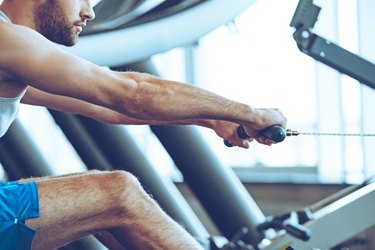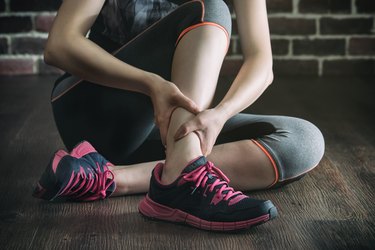
A broken ankle means traditional cardio, such as running, cycling or dancing, are out of the question. You don't have to entirely give up on fitness as you heal, however. Use your upper body to get a sweat going and keep contributing to your fit physique.
An upper-body cardio workout when you have a broken ankle has to keep you on dry land — to protect your cast — but be intense enough to raise your heart rate. Enter the arm cycle ergometer. This machine has a crank like a stationary bicycle, but smaller and upright. You sit on a padded seat behind handles that you pedal with your hands and arms.
Video of the Day
Video of the Day
Some select fitness centers offer group fitness classes, entitled "Kranking," to guide workouts on these machines. If, however, you don't have access to such a class, create your own workout as your ankle mends.
Arm Ergometer Potential
If you're skeptical of the potential of the arm ergometer, consider research published in a 2010 issue of the Journal of Strength and Conditioning Research. Dutch researchers compared fitness testing performed on a traditional cycle ergometer to that done on an arm ergometer and found both equally effective in measuring physical fitness.
Other research performed by the American Council on Exercise in 2010 determined that workouts using the arm ergometer are intense and effective in boosting aerobic capacity and burning calories.
Read more: Arm Ergometer Exercises
Design a Workout
Set yourself up on the arm ergometer and set the crank shaft to shoulder height. The length of the crank should be such that one elbow extends while the other arm remains in front of the body. If you have questions about proper adjustments for your body, consult fitness floor staff.
An arm ergometer workout begins with a warm up of five to 10 minutes. Use this time to pedal your arms at a modest pace and become accustomed to movement pattern.
You then adjust the difficulty of the ergometer by changing the speed at which your arms pedal and the resistance of the machine. A circuit of interval training on the ergometer helps you sustain a challenging rate of work without wearing out.
A 3-minute circuit might look like this:
- 30 seconds pedaling as fast as you can
- 30 seconds easy pedaling
- 30 seconds at a high resistance, slower strokes
- 30 seconds easy pedaling
- 30 seconds right arm only
- 30 seconds left arm only
Repeat three to eight times, depending on your stamina and cardio capacity. Between each circuit, pedal your arms at an easy pace for one minute.
As you become more proficient on the arm ergometer, consider increasing the time spent at each challenge to 45 or 60 seconds, but keeping the easy pedaling intervals at 30 seconds.

Be Patient
Most people aren't accustomed to using their arms in the vigorous manner required by the cycle ergometer. Your muscles may fatigue sooner than your cardio stamina. When starting out, consider performing 10- to 15-minute bouts on the machine, one to three times per day. Over time, extend the length of your workout sessions. A 30-minute session several times per week helps build cardio and respiratory stamina and fitness.
Augment your arm ergometer training with upper body workouts to build up muscular strength and endurance. A broken ankle doesn't affect your ability to do curls, triceps extensions and shoulder presses with dumbbells. If getting into a traditional hinged position for rows is challenging, use a resistance band attached to a fixed pillar. Train your chest with a resistance band as well.
It typically takes six months for your broken ankle bones to heal, and may take longer for the surrounding connective tissue to bounce back. Even after your cast is off, your lower-body movement may remain limited. Always follow your doctor's advice when it comes to returning to putting weight on the foot and resuming more traditional cardio activity.